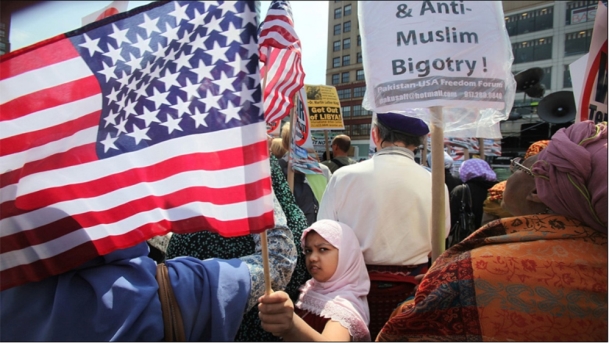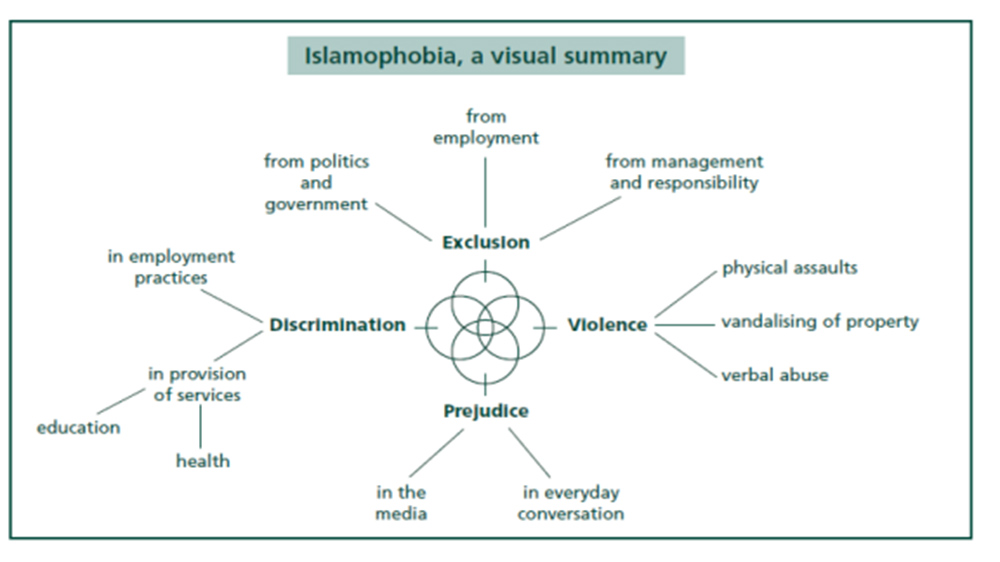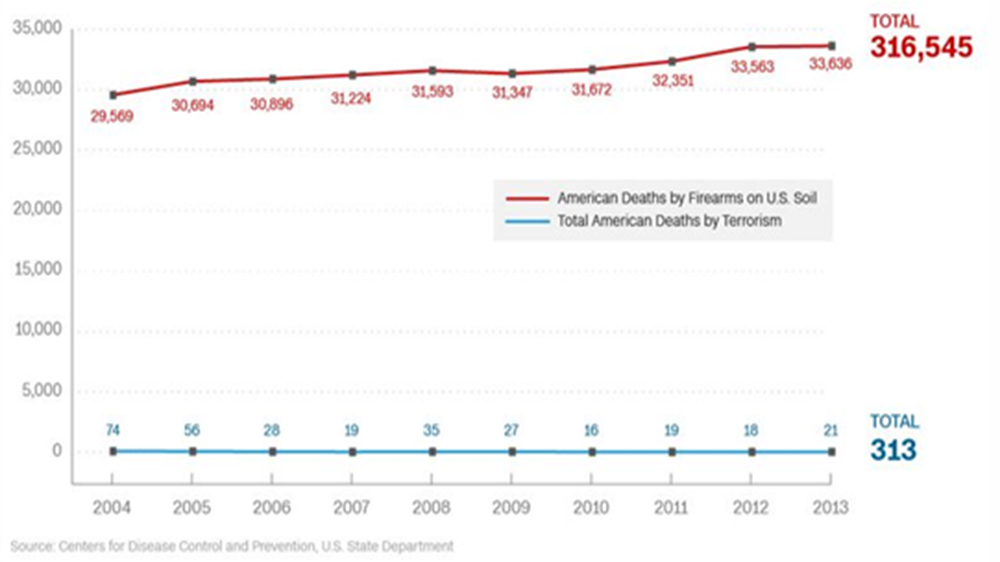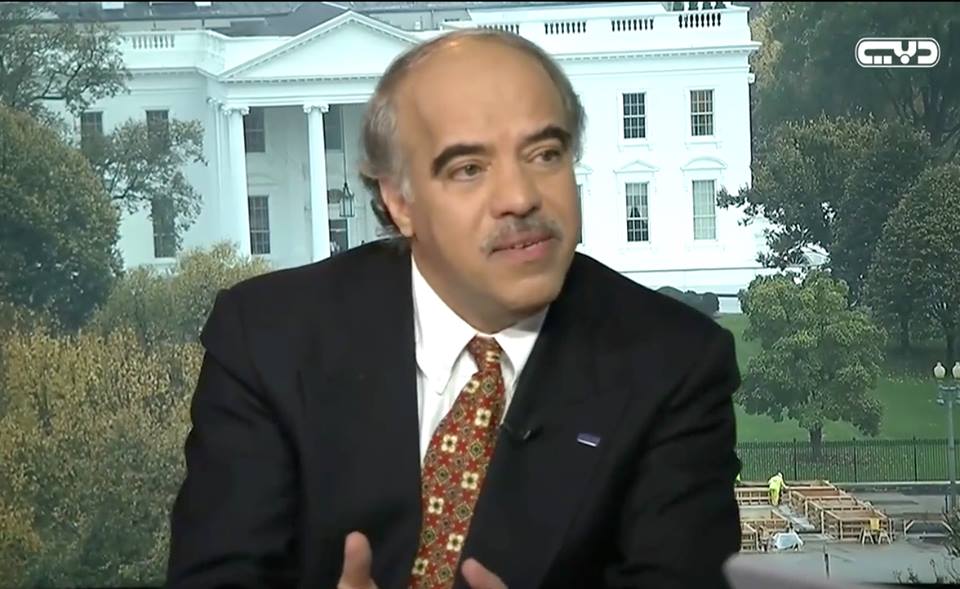
Most observers worldwide have been bewildered by Trump's success in securing the nomination of the Republican Party in 2016 despite his discriminatory and denigrating statements about Mexicans, Muslims, minorities, and Syrian refugees. He has been celebrated as the ‘hero’ of Islamophobia and Hispanophobia. His call for a ban on Muslims’ travel to the United States and his antagonizing phrase "Islam hates us" have reached some uncharted territories of the ideological underpinnings of any presidential bid for the White House. To help deconstruct the rise of Islamophobia in this non-orthodox election year, one needs to do some contextualization, or to borrow British philosopher Gilbert Ryle’s [1900-1976] term, some thick description of this emerging trend to help deepen the attention to the meaning of actions. Accordingly, this two-part report aims at showcasing the correlation between the resurrection of the American conservative movement, and the right-wing opinionated media. The first part focuses on the ideological and meaning-making precursors and drivers of the unprecedented degree of Islamophobia. The second part tracks down the rise of Trumpism as a provocateur of anti-Muslim politics and xenophobia, and presents a number of propositions about what can be reconstructed beyond the challenges of the Islamophobic discourse as well as the nuances of a much-needed Islamic narrative in the West.
Introduction
American Islamophobia is often conceived as an irrational fear of Muslims as it characterizes them as an ‘evil group du jour’. Several layers of biases, prejudices, and stereotypes of ‘scary’ and ‘non-trustworthy’ Muslims have been generated by the entertainment industry in Hollywood and the so-called conservative media. As Gabriel Arana, the Huffington Post Senior Media Editor, points out, “some of the bad coverage is the result of willful prejudice and ignorance; it’s hard to imagine any amount of information getting the Sean Hannitys and Bill O’Reillys [top-rated talk show hosts in FOX News] of the world to stop spreading hate.” (1)
Twenty years ago this month, Australian-born American media mogul Rupert Murdoch decided to establish FOX News as an ideological bastion of the conservative base. Spin journalism has been on the rise as the baseline of the new network in its battle with liberals with the aim of solidifying the power of right-wing politics and taking revenge from the Clinton years [1993-2001]. The late New York Times columnist William Safire defined “‘spin’ as the act of selectively describing or interpreting an event in a way that patently favors a partisan interest. Eight years later, the Network was credited with a major contribution to the re-election of George Bush in the presidential ballot of November 2004. Over the years, it has developed the label of “the Islamophobia Channel” in America.
FOX News emerged amidst the debate over the status of the United States, as the new sole superpower, after the collapse of the Soviet Union and the end of the Cold War era. One the narrative and cultural precursors of the anti-Muslim and anti-minority FOX News can be traced to two specific publications of Samuel Huntington: The Clash of Civilizations and the Remaking of World Order published in 1996 three years after his essay Clash of Civilizations in Foreign Affairs magazine.
As Huntington hypothesized the imminence of “civilizational conflicts” in the new century, he pointed to the "bloody borders" between Islamic and non-Islamic civilizations. At the end of the essay, he wrote, “this is not to advocate the desirability of conflicts between civilizations. It is to set forth descriptive hypothesis as to what the future may be like.” This is a clear insinuation of the suggestive build-up for the Islamophobic battle!
As for the Fox News-Trump drive for Hispanophobia and other trends of xenophobia, it has worked off another book written by Huntington entitled Who Are We? The Challenges of America’s National Identity in 2004 shortly after the 9/11 attacks, where he tried to validate the intensification of the national security politics, and the we/they dichotomy between the white majority and the growing ethnic and religious minorities within the United States.
A few years earlier, the American depiction of the Middle East – both Muslim and Christian – was manufactured through an Orientalist lens. In a detailed article published in 1980, late Edward Said wrote: “It is only a slight overstatement to say that Muslims and Arabs are essentially seen as either oil suppliers or potential terrorists. Very little of the detail, the human density, the passion of Arab-Muslim life has entered the awareness of even those people whose profession it is to report the Arab world. What we have instead is a series of crude, essentialized caricatures of the Islamic world presented in such a way as to make that world vulnerable to military aggression. I do not think it is an accident.” (2)
Over the last thirty-six years, the Arab-Muslim image was what I call the image of reference as construed by the media and Hollywood after replacing the Soviet “red enemy” by the Iranian Islamic “green enemy” amidst the showdown between Reagan’s America and Khomeini’s Iran. In the post-9/11 era, this image has shifted into an image of utility, as we have seen so far in the public discourse during the election year. Subsequently, the connotations of Islamophobia have gone into darker areas in the conservative media discourse where Muslim identity and the concerns of Muslims are increasingly being defined in terms of “an oppositional dialectic that pits Islam and Muslims against the rest of the world.” (3)
Some analysts have noticed that “whenever the Islamic religion appears in American mass media, it’s a one-sided portrayal that only focuses on the actions and beliefs of extremists. While these forms of entertainment aren’t technically stating incorrect facts, they are directly producing an image that is incorrect, one of the world’s second most populated religion as threatening, violent, and hateful.” (4) By the same token, Edward Said underscored the point that “both media meanings of “Islam” depend on each other, and are equally to be rejected for perpetuating the double bind.” (5)
For instance, Brian Kilmeade of Fox & Friends claimed that “not all Muslims are terrorists, but all terrorists are Muslims”, and Bill O’Reilly has implied that all Muslims were responsible for 9/11. Fox News regularly hosts anti-Muslim guests such as Brigitte Gabriel, Robert Spencer, and Pamela Geller whose organization is classified as a “hate group” by the Southern Poverty Law Center.
Recently in the wake of the Orlando attacks when Omar Matine killed 49 individuals in a nightclub, Fox News host Greg Gutfeld accused the left for being ‘obsessed’ with identity politics that has created a blame game pointing at everything except the perpetrator and the ideology that drove him. "The orgy of blame generated by competing identities obscures a gleeful enemy that now nails soft targets at will. Deflection is denial, as we can't admit the problem, which is Islamism." Gutfeld also made this alarming suggestion: "Send everyone to 'Islamophobia-phobia Anonymous' to get over your fear of being called Islamophobic. Because it's not just a fear, it's gonna be our doom." (6)
FOX News’s narrative and Trump’s political discourse have harmonized each other within the silo of right-wing conservatism by disseminating fear, intolerance, and prejudice. While preparing for his Republican Party convention in Ohio in July 2016, Trump sent this alert: “We need to tell the truth also when radical Islam is coming to our shores. With these people, folks, it’s coming.” (7) This sounded like a breaking news alert that energized the appetite of conservative pundits on FOX News to fill in the air with their own ‘perceptions’ of Muslims and ‘interpretations’ of Islam.
This is a good example of the ideological mobilization of typical authoritarian voters, like Trump’s supporters, who absorb these messages that construct fear of a specific “other” in their minds. Political scientist Stanley Feldman conceives Trump’s approach as "the classic authoritarian leadership style: simple, powerful, and punitive,” (8) while putting the blame of all America’s problems over the shoulders of one particular social group.
There seems to be “no bottom to the cesspool of Islamophobic rhetoric” coming from Republican candidates, as Charles Blow points out in his Op-Ed Anti-Muslim Is Anti-American, “the tone of anti-Muslim musings post-Paris attack has become so poisonous that it cannot portend anything positive.” (9) As a result, violence against Muslims appeared to level off in the beginning of 2016 and still remained 3 to 5 times higher than pre-election levels, according to Georgetown University’s Bridge Initiative, which tracks the connection between increasingly inflammatory political rhetoric and the rise of Islamophobia in the United States.
President Obama has been aware of the growing concerns among the Muslim-American community as he stated “that’s an anxiety echoed in letters I get from Muslim Americans around the country. I’ve had people write to me and say, I feel like I’m a second-class citizen.” (10)
Still, most Americans remain unfamiliar with Islam while the media tend to capitalize on that with fear-mongering and unfair lines of questioning after Islamist terrorist attacks, according David Auberti, author of Best and Worst Journalism of 2015. What is alarming here is the possible is the rise of Islamophobic politics not only in Congress, but also across several of the so-called called ‘red’ states as historical base of Republican voters as we will see later in this report. As Auberti cautions, “the worry is that such reactionary coverage will influence policy makers to take drastic measures under the guise of popular fears. And that threat is very real, if Trump’s candidacy is any indication.” (11)
Before we explore how the new image of utility of ‘bad’ Muslims has been construed, let’s address the evolution of Islamophobia, as a term, and what it should invoke in the study of Islam and Muslim communities in the West.
Conceptualization of Islamophobia
The media and academia have embraced the term "Islamophobia" which was highlighted in a 1991 Runnymede Trust Report written by a number of British-Muslim activists in the context of the United Kingdom in particular and Europe in general within the more common "xenophobia" framework. The Report defined Islamophobia as “"unfounded hostility towards Muslims, and therefore fear or dislike of all or most Muslims."
However, the term goes back to 1923 when it meant “intense dislike or fear of Islam, esp. as a political force; hostility or prejudice towards Muslims” according the Oxford English Dictionary. Still, the Report explains the political, socio-economic, and socio-psychological ramifications of Islamophobia for a sizable segment of European and American populations as illustrated in Figure one.
 |
|
Figure 1: American Deaths by Deliberate Violence 2004-2013 [Source: U.S. Centers for Disease Control and Preservation] |
One of the most nuanced concepts of Islamophobia was proposed recently in a study commissioned by the Council for American-Islamic Relations (CAIR) and completed by U.C. Berkeley Center for Race and Gender. It defines Islamophobia as “a contrived fear or prejudice fomented by the existing Eurocentric and Orientalist global power structure. It is directed at a perceived or real Muslim threat through the maintenance and extension of existing disparities in economic, political, social, and cultural relations, while rationalizing the necessity to deploy violence as a tool to achieve “civilizational rehab” of the target communities (Muslim or otherwise). Islamophobia reintroduces and reaffirms a global racial structure through which resource distribution disparities are maintained and extended.” (12)
Later in the report, I will discuss what goes into the process of “rationalizing” the necessity to deploy violence - verbal, physical, of structural - against Muslims.
The illogical ‘Logic’ of Constructivism
The disputed irrationality of Islamophobia in targeting a sizable global Muslim community, including 6 to 8 million Muslim Americans, seems to compile its own subjective stereotypes and stigmas regardless of any objective knowledge of Islam. It has correlated with political violence, fear, the growing security paradigm, and the uncontested xenophobia in the United States.
However, statistics of violence do not support the expansion of Islamophobic attitudes. Between September 2001 and June 2015, nearly twice as many people were killed by white supremacists, anti-government fanatics, and other non-Muslim extremists than by radical Muslims: 48 were killed by extremists who are not Muslim compared with 26 by self-proclaimed jihadists, according to a count by New America, a Washington research center. (13)
John G. Horgan, who studies terrorism at the University of Massachusetts at Lowell, said the mismatch between public perceptions and actual cases had become steadily more obvious to scholars. “There’s an acceptance now of the idea that the threat from Jihadi terrorism in the United States has been overblown; and there’s a belief that the threat of right-wing, antigovernment violence has been underestimated.” (14)
As illustrated in Figure 2, firearm-related acts of violence killed 316545 individuals whereas only 313 individuals lost their lives to violent attacks categorized under terrorism and perpetuated by Muslim and non-Muslim individuals between 2004 and 2013. Ironically, the National Rifle Association (NRA) has been powerful enough, in the media and at the Congress, in suppressing any emerging blame for deaths by hand arms and automatic machine guns.
 |
| Figure 2: American Deaths by Deliberate Violence 2004-2013 [Source: U.S. Centers for Disease Control and Preservation] |
Other empirical data have shown more staggering facts: 382 police and sheriff’s departments nationwide were asked to rank the three biggest threats from violent extremism in their jurisdiction. About 74 percent listed antigovernment violence, while 39 percent listed “Al Qaeda-inspired” violence, according to the researchers, Charles Kurzman of the University of North Carolina and David Schanzer of Duke University. (15)
Still, several analysts argue this kind of demonizing of American Muslims isn’t just “a problem with specific American politicians like Cruz or Trump. Rather, it’s a problem with American politics — and that means that it will stay with us long after this election is over.” (16)
This is one more reason not to waste effort and time in contesting Islamophobia from a normative or value-system perspective. Instead, I advocate a constructivist approach to the study of Islamophobia. I argue that it is one of the political subjectivities derived from what many conservative Americans have developed inside their heads about what they believe should depict Muslims versus who they are on their own merit.
As German philosopher Jürgen Habermas once said, the media have “colonized’ the lifeworld.” (17) As I argued in another publication, “we have become fully mediatized in the sense of absorbing, digesting, and constructing our views and positions from the global 24/7 media. The media should rather be understood as an “ever-present social and cultural system of pro¬duction, broadcast, circulation, and dissemination of symbols, signs, mes¬sages, meanings, and values.” Amidst the strong tide of mediatization and technological determinism, media frames and their political and cultural nuances tend to penetrate deeper into our consciousness and meaning-making more that we can measure either quantitatively or logically.” (18)
Individuals tend to be selective about certain networks and newspapers since they help them reinforce their ideas and judgments and ultimately solidify their positions and worldviews. Clinical psychologist Donald C. Klein (1923-2007) once said “I realized that the world of thought includes the very core of our images of ourselves: the beliefs, and ideas having to do with who we are and who we want to be. We cling to that world because it defines us in terms both of our individual and collective selves… People – individually and collectively – are driven by their thoughts;” As Klein noticed, “the only reality we can ever know is that which exists in our minds… In effect, we are continuously engaged in creating the reality in which we function.” (19)
I perceive Islamophobia as a negative construct energized by the multiplicity of meaning-making processes and realities, and cannot be detached from individuals’ interactions and consumption of the media content. One recent study that analyzed Fox News viewers' anti-Muslim feelings reported, for example, that 60% of Republicans who most trusted Fox News also believe that Muslims were attempting to ‘establish’ Sharia law in the United States. Those trusting Fox News the most also tend to believe that Islamic values are ‘incompatible’ with American values (68%). That percentage is lower for those who most trust CNN (37%) or public television/new [media] (37%). (20)
One social encounter experienced by Julia Ioffe, the New York Times Magazine writer, illustrates this tendency toward the constructivist representation of Muslims in America. Julia was at one dinner party when conservative radio talk show host and political commentator Laura Ingraham turned to the other guests and took a poll: “Raise your hands if you think Islam is a death cult. Most of the (politically conservative) guests raised their hands and then took pains to explain to me how, unlike Islam, Christianity is inherently a religion of love. With all due respect to my many Christian friends, I seriously beg to differ.” (21)
While penning his Autobiography, novelist Mark Twain wrote an interesting reflection which is valid in capturing the reality in which Trump and his supporters function; "life does not consist mainly - or even largely - of facts and happenings. It consists mainly of the storm of thoughts that is forever blowing through one's head.”
American cultural sociologist Jeffery Alexander argues for the new tendency of election campaigns as a political performance. He focuses on the underlying cultural link which can help explain Trump’s popularity among his supporters. As Alexander points out, “social meanings have their own internal logic… When political actors act and speak, they evoke meanings and symbolic weight. They see themselves in terms of exemplary models of speaking and acting that culture provides, and they wish to persuade audiences to see them in the same way.” (22)
The same constructivist approach to depicting Muslims and Arabs was dominant during the rise of Arab oil as a world commodity in the sixties, and the irony of the growing strategic significance of the region. Edward Said argues that the substitution of the British and French empirical presence in the Middle East and North Africa by the newly-American hegemon after WWII has resulted into two shifts:
“First, a remarkable burgeoning of academic and expert interest in Islam, and, second, an extraordinary revolution in the techniques available to the largely private-sector press and electronic journalism industries. Together these two phenomena, by which a huge apparatus of university, government and business experts study Islam and the Middle East and by which Islam has become a subject familiar to every consumer of news in the West, have almost entirely domesticated the Islamic world. Not only has that world become the subject of the most profound cultural and economic Western saturation in history–for no non-Western realm has been so dominated by the United States as the Arab-Islamic world is dominated today–by the exchange between Islam and the West, in this case the United States, is profoundly one-sided.” (23)
second part of this report, I will address what has emerged at this age of Islamophobic politics under the Trump factor, and the deliberate engineering of social sub-identities with the pursuit of othering Muslims and Muslim Americans inside the United States. I will also suggest a number of propositions about how to face the challenge of Islamophobic politics.
(1) G. Arana, “5 Ways Journalists Can Avoid Islamophobia in Their Coverage”, The Huffington Post 13 December 2015 (Visited 12 January 2016) http://www.huffingtonpost.com/entry/journalists-islamophobia- coverage_us_566ec22ae4b0e292150e60db
(2) E. Said, “Islam through Western Eyes”, the Nation, 26 April 1980, (Visited 16 May 2011) https://www.thenation.com/article/islam-through-western-eyes/
(3) F. A. Noor, “Mediating the Mediated Image of Islam: Multiple Audiences, Differentiated Constituencies in the Global Age”, in Abdul Rashid Moten and Noraini M. 2007, p. 267
(4) S. Zacher, “The Case for Tolerance: Examining Islam in the West”, The Gate: Political Analysis and Opinions from the University of Chicago, 3 May 2015 (Visited 8 May 2015) http://uchicagogate.com/2015/05/03/the-case-for-tolerance-examining-islam-in-the-west/
(5) E. Said, “Islam through Western Eyes”, the Nation, 26 April 1980, (Visited 16 May 2011) https://www.thenation.com/article/islam-through-western-eyes/
(6) G. Gutfeld, “Gutfeld: Fear of Being Labeled 'Islamophobic' Will Be Our Doom, 15 June 2016 (Visited 19 June 2016) http://insider.foxnews.com/2016/06/15/gutfeld-fear-being-labeled-islamophobic-will-be-our-doom
(7) T. Hains, “Trump: We Need To Tell The Truth; Radical Islam Is Anti-Woman, Anti-Gay, Anti-Jewish”, Real Clear Politics, 13 June 2016 (Visited 14 June 2016) http://www.realclearpolitics.com/video/2016/06/13/trump_we_need_to_tell_the_truth_radical_islam_is_anti-woman_anti-gay_anti-jewish.html
(8) A. Taub, “What Ted Cruz said about Muslims is scary. The reason he said it is scarier”, Vox Policy and Politics, 24 March 2016 (Visited 27 March 2016) http://www.vox.com/2016/3/24/11300672/cruz-muslim-authoritarian-fear
(9) C. Blow, “Anti-Muslim Is Anti-American”, The New York Times, 23 November 2015 (Visited 25 November 2015 http://www.nytimes.com/2015/11/23/opinion/anti-muslim- is-anti-american.html?_r=0
(10) B. Obama, “President Obama about Islam in America”, Islamic Society of Baltimore, 3 February 2016 (Visited 5 February 2016) https://www.whitehouse.gov/the-press-office/2016/02/03/remarks-president-islamic-society-baltimore
(11) D. Auberti, The Best and Worst Journalism of 2015”, , Columbia Journalism Review, 8 December 2015 (Visited on 25 December 2015) http://www.cjr.org/analysis/the_best_and_worst_journalism_of_2015.php
(12) CRG/ CAIR “Islamophobia and its Impact in the United States: Confronting Fear”, 6 June 2106 (Visited 8 June 2016) p. x http://www.islamophobia.org/15-reports/179-confronting-fear-islamophobia-and-its-impact-in-the-u-s-2013-2015.html
(13) S. Shane, “Homegrown Extremists Tied to Deadlier Toll Than Jihadists in U.S. Since 9/11”, 24 June 2015 (Visited 2 July 2915) http://www.nytimes.com/2015/06/25/us/tally-of-attacks-in-us-challenges-perceptions-of-top-terror-threat.html?_r=0
(14) S. Shane, “Homegrown Extremists Tied to Deadlier Toll Than Jihadists in U.S. Since 9/11”, The New York Times, June 24, 2015 (Visited on 25 December 20http://www.nytimes.com/2015/06/25/us/tally-of-attacks-in-us-challenges-perceptions-of-top-terror-threat.html?_r=0
(15) S. Shane, “Homegrown Extremists Tied to Deadlier Toll Than Jihadists in U.S. Since 9/11”, The New York Times, June 24, 2015 (Visited on 25 December 2015 http://www.nytimes.com/2015/06/25/us/tally-of-attacks-in-us-challenges-perceptions-of-top- terror-threat.html?_r=0
(16) A. Taub, “What Ted Cruz said about Muslims is scary. The reason he said it is scarier”, Vox Policy and Politics, 24 March 2016 (Visited 27 March 2016) http://www.vox.com/2016/3/24/11300672/cruz-muslim-authoritarian-fear
(17) J. Habermas,. The Theory of Communication Action. Lifeworld and System; A Critique of Functionalist Reason (T. McCarty, Trans. Vol. 2) (Polity Press, 1987).
(18) M. Cherkaoui, D. Rothbart, and K. Korostelina. Civilians and the Ideology of Modern War, Routledge, 2012, p. 203
(19) D. Klein, “The Humiliation Dynamic: Looking to the Past and Future”, Presented at the Annual Meeting of the Human Dignity and Humiliation Studies Network, Columbia Teachers College, New York City, December 15-16, 2005
(20) C. Ogan, "The rise of anti-Muslim prejudice: Media and Islamophobia in Europe and the United States", International Communication Gazette, February 2014, 76 (1): 27–43.
(21) J. Ioffe, “If Islam Is a Religion of Violence, So Is Christianity”, Foreign Policy, 14 June 2016 (visited 17 June 2016) http://foreignpolicy.com/2016/06/14/if-islam-is-a-religion-of-violence-so-is-christianity/ utm_source=Sailthru&utm_medium=email&utm_campaign=New%20Camp aign&utm_term=Flashpoints&wp_login_redirect=0
(22) J. Alexander, Performance and Power, 2011, Polity, p. 281
(23) E. Said, “Islam through Western Eyes”, the Nation, 26 April 1980, (Visited 16 May 2011) https://www.thenation.com/article/islam-through-western-eyes/
